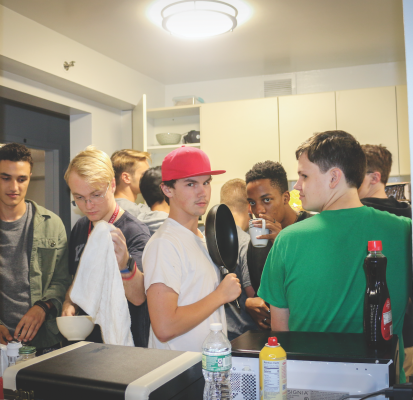Influx of Freshmen Forces Triples in McMahon

Freshmen in a nine-person suite cook dinner in close quarters. (Matt LaBarbera/The Observer)
September 12, 2018
The safari-themed doors of McMahon Hall’s second and fifth floors are teeming with fern leaves and pith helmets marking the names of freshman residents — up to nine in one suite. The freshman class’ title as Fordham College at Lincoln Center (FCLC)’s largest class yet comes with an increased need for on-campus housing, which has led the university to convert McMahon’s double rooms into triples.
While freshmen triples have previously occurred in McMahon, this year’s increased population has led to at least one triple in every room — in the most crowded dorms, up to nine people share one fridge and six people share one bathroom. On move-in day, freshmen in triples arrived to find their bedrooms set up to accommodate enough furniture for three people in rooms usually used for two, which meant desks and dressers in closets and bunked beds.
First-year students were alerted to the possibility of forced triples early on during the summer and were notified of their status through their housing assignment email by the second week of August. Students living in a triple receive the accommodation of a reduced rate, paying $5912.50 per semester rather than the standard $8262.50 in McMahon.
Jenifer Campbell, senior director of residential life, told The Observer that Fordham followed procedure from earlier years and utilized the building floor plan’s information about room size to select which rooms could become triples. Despite this precaution, many freshmen still find their living quarters to be cramped.
“There’s not enough space for everything,” Laura Vasquez, FCLC ’22, said. “One of the dressers was just in the closet when I came in, so I had to move everything around myself and see how I was going to fit it.” Vasquez, like many other freshmen, relocated her desk to the living room in order to clear up space in her and her roommates’ bedroom.
“Seeing the space, it kind of felt like they just stacked two beds on top of each other and didn’t really accommodate much else, in my opinion,” Sydney Ebbeler, FCLC ’22, said of her room on move-in. “The room just feels smaller … if everyone is in the room all at once, it’s just a lot of having to navigate around each other.”
Ebbeler lives in a dorm with two triples and confessed the most difficult part of her living situation was sharing one bathroom between the six of them. “We had to have a roommate meeting to make sure there are no disputes over the bathroom,” she said as she pointed to a calendar filled with color-coded shower times for each member of the suite hangs on their wall. “We came up with a schedule of who showers in the morning, who showers at night, if someone has an 8:30 class, they need to use it before someone else who usually uses it in the morning … we’re still trying to figure out a good flow to it.”
Other than their reduced room rate, freshmen in forced triples did not receive any other accommodations or resources specific to living with an increased number of suitemates.
The resident assistant and resident freshman mentor for the McMahon freshman floors were alerted during training in August about the forced triples but were not given any additional training in response to the increased number of residents.
Residential Life did not say if the RFM received additional compensation for their extra responsibilities other than the standard half room rate and meal check. This increase in the number of residents on the floors, without a proportionate raise in benefits, means that the floors’ RFM still pays half of their room and board with nearly twice as many residents to take care of.
The floors’ former RA, who spoke to The Observer under condition of anonymity, resigned their post after learning how many residents they would be in charge of. “I was afraid I’d be spread too thin,” they said of their reasons behind leaving. “I worried I wouldn’t be able to give them the time and commitment … [to] have the best freshman year experience they could have.”
In order to ensure McMahon freshmen can participate in freshman programming held in McKeon Hall, Residential Life set up a system between the two buildings in which McMahon freshmen can identify themselves to security personnel via a sticker on their ID and sign themselves in between the hours of 6 a.m. and 10 p.m.
Despite the self-sufficient system, Ebbeler says she still feels “very separate” from the freshmen in McKeon. “I know they [Residential Life] want to create a freshman community in McMahon … but I think everybody is kind of on the same page of wanting to be able to be included in everything in McKeon.”
Amid the crowding and confusion, however, residents in the forced triples have also come to appreciate the opportunity for community-building within suites that the situation presents. Aiden Tice, Gabelli School of Business (GSB) ’22, who lives in a nine-person suite, said he actually enjoys the bunk beds and credited the close quarters for he and his roommates’ strong friendship so early in the year.
“Both of my roommates are from China and I ended up taking four years of Chinese in high school, so we talk all the time,” he said. “While it may not have been ideal at first, nine people in a room is bringing us all together.”
Vasquez held similar sentiment: “Me and my roommates, we’re all chill with each other … We haven’t known each other that long, but we’ve already got a friendship.” While Vasquez admitted the forced triples weren’t ideal, she has found one definite advantage in the support of her new bunkmates: “I think that could be an advantage sometimes, having two roommates instead of one.”












Alumnus • Sep 13, 2018 at 5:00 pm
This is appalling.